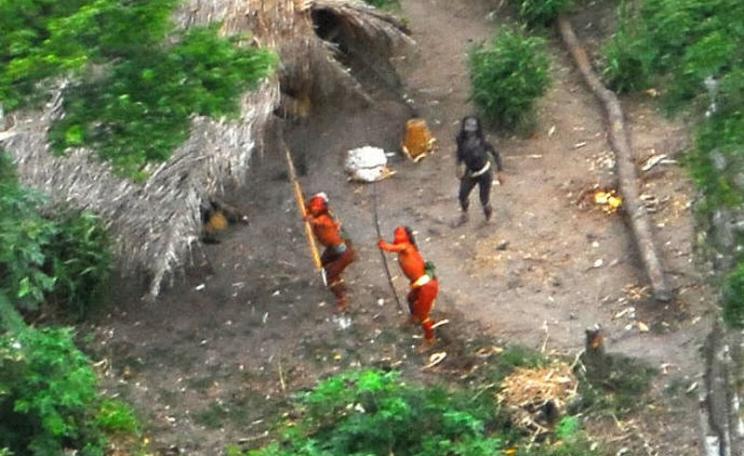One man, Pedro, led the charge against privatisation by attempting to exercise his rights. But he discovered that the infrastructure needed for him to enjoy his rights did not exist, and that an array of forces was undermining his attempts to do so.
European colonial projects depended on the racialisation of native populations to maintain their economies of plunder.
The belief that indigenous peoples were inherently unable to enjoy the same rights as colonists undergirded colonial civil society and legitimised, in contemporary eyes, brutal exploitation and even genocide.
Europeans from Juan de Matienzo in the 16th century to Mario Vargas Llosa more recently have furthermore argued that these costs were worth paying, as European colonialism brought with it enlightened civilisation. The ends, they have said, justified the means.
Troubling echoes of this mentality are still apparent today, namely in the Peruvian government's approach to indigenous land rights. The current neoliberal project centres on the concept of market rule: governments must alter all goods and services so they can be traded in the global marketplace.
In highland Peru, new laws enabled the marketisation of indigenous lands, explicitly promoting dispossession as the most efficient outcome and therein improving the wellbeing of all.
'Efficiency demands enclosure of the village commons!'
"This model of smallholders without technology is a vicious circle of extreme poverty", explained Peru's president Alan García in 2007. "We must encourage medium-sized property, the middle class of farmers who know how to obtain resources, seek out markets and create formal jobs."
Nevertheless, Peru's recent law on land ownership, passed in 1995, paternalistically provides rights specifically for natives, the majority of smallholders, out of respect for traditions going back to 'ancient times'.
Only 17% of all landholdings in Peru have clear title, with the number much lower in the Andes. In order to rectify this, the new legislation allows that "under current law, the titling of the communities can take two modalities: communal or individual."
That is, the law provides for clear private titles as well as for titles based on the indigenous-associated community system, which is protected against taxation and appropriation in order to enable the poor to keep their lands as the basis of their survival.
The law further holds that the lands of indigenous communities can only become private if a majority of the villagers vote in favour of privatisation (at the time of passage the proportion needed was set at two-thirds).
Rights to maintain communal title exist - but only on paper
I conducted a multi-year ethnographic study in the village of Huaytabamba (all names are pseudonyms) from 1999 to 2003, where a fierce battle over privatising the lands had broken out. Located twelve twisty kilometres above the regional capital of Ayacucho in south central Peru, villagers in this Quechua-speaking community survive on less than a dollar a day.
One man, Pedro, led the charge against privatisation by attempting to exercise his rights. But he discovered that the infrastructure needed for him to enjoy his rights did not exist, and that an array of forces was undermining his attempts to do so.
The food they eat primarily comes from their own fields. Only four families wished to privatise lands, whereas more than 30 adamantly opposed it for fear of once again becoming beholden to a draconian landed elite.
One man, Pedro, led the charge against privatisation by attempting to exercise his rights as given by the new law. However, Pedro not only discovered that the infrastructure needed for him to enjoy his rights did not exist, but also that an array of forces was actively undermining his attempts to do so.
In other words, Pedro found neoliberalism reproducing colonial forms of racial domination that confined him to rightless status and allowed for the seizure of his lands.
First, the government's 'special land titling project' (PETT in its Spanish acronym), which was charged with implementing the law, did not provide for the community-based option. It only supplied private titles.
This was in part because PETT personnel viewed private titles as the superior option. They described these in interviews as simple resources for improving wellbeing, as they provided access to cash through loans and sales, something community-held titles did not do. They therefore saw the desire to keep the land communal as irrational.
Democratic rights trampled in drive to privatise
Pedro and his allies thus turned to the second protection mechanism included in the law: the need for a majority vote. In stark contrast to national elections, which are strictly regulated so as to minimise manipulation by the powerful, PETT provided neither resources nor guidance to local communities in order to ensure the fidelity of the vote. The villagers were simply left to their own devices.
Pedro saw his chance when it became his turn to act as president of the community, and he brought the issue to a vote in the village assembly. Villagers soundly defeated the issue, with over 90% voting against privatisation. The village elite responded with blatant disregard, and despite the fact that the vote was held in accordance with the new law they persisted in their attempts at privatisation.
Pedro and his backers attempted further votes that would more concretely solidify the popular will as the law of the village. They exacted commitments from all major regional authorities to come regulate the decision making process, including the mayor, the district governor, and a judge.
Against this threat, the village privatisers launched a vicious campaign condemning such actions as external manipulation that undermined village sovereignty. That this sovereignty was based on the community government, the specific entity the privatisers sought to eliminate, was immaterial.
The actions against the district mayor were particularly vicious. The privatisers denounced the mayor, including through the Quechua language radio station, for building a school that had never seen a student because it had immediately flooded. They accused him of undertaking the project only to win votes. As one worker put it, "the mayor got them all to vote for him and now this school is flooded."
The privatisers condemned the mayor, saying, "this is not a school; this is only a corral; you who have been a teacher and now are mayor should fix it." While the school construction was clearly corrupt, what the privatisers conveniently overlooked was that the project was brokered locally by one of their own.
The mayor, like the other officials, did not expect such brazen hostility. They assumed their roles would be more formal and based on their authority. Thus, when they were blindsided, they quickly pulled back from their promises. On the day Pedro had scheduled external authorities to come help, he and I scoured the provincial capital to get them to make good on their promises. But we only found locked doors.
These urban authorities had no institutional or legal obligation to fulfil a regulatory role, and they gladly fell back on this lest the accusations of manipulation stick on them and ruin their careers. Thus, in simply doing their job, these officials helped preserve the system in which the indigenous do not enjoy substantive rights.
False friends in the City
Pedro's urban allies provided the greatest betrayal. The community faction secured village presentations from three different organisations, believing that a village vote would immediately follow based on the information provided.
For instance, when Pedro and I visited the defensoría del pueblo, the government sponsored human rights ombudsman, the young lawyer working there explained the law in easy terms and said he would have no problem making a presentation to the village.
An Ayacucho non-governmental organisation and the secretary general of the Peruvian Peasant Confederation (CCP) made similar presentations. All these organisations agreed with the majority that privatisation was against its best interests.
But these organisations - the community's greatest urban allies - refused to help regularise the voting process. They demurred not because of threats from the privatisers, but rather because they saw facilitating an intimidation-free vote as interfering with local self-determination. So they declined offers to help regulate a vote because they thought they were respecting village autonomy, not helping to undermine it.
Such behaviour denied the manipulative informality dominating political processes in Huaytabamba. It instead presupposed the existence of local mechanisms to guarantee a free and open vote, even though these organisations were aware that the privatisers fearlessly employed intimidation and fraud to get their way.
While these organisations did not want to give the impression of manipulating the process, they did nothing to moderate the rampant coercion and therefore countenanced it through inaction.
In this way, foes, friends, and all levels of government worked together to undermine the desires and rights of the indigenous villagers, and thus to give them a push down the path to dispossession.
Arthur Scarritt is an associate professor in the department of sociology at Boise State University. In his new book, 'Racial Spoils from Native Soils: How Neoliberalism Steals Indigenous Lands in Highland Peru', he explains how the key mechanisms militating for indigenous subordination have persevered throughout the centuries despite creative indigenous resistance and epochal changes.
This article was originally published by openDemocracy under a Creative Commons Attribution-NonCommercial 4.0 International licence.





